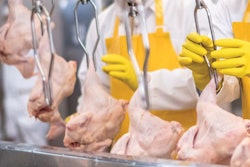
The Brazilian poultry industry is expecting significant growth this year, building on its strong performance in 2019, according to forecasts from Brazilian Association of Animal Protein (ABPA).
The turnaround has come after a period of difficulties for the Brazilian broiler industry; however, according to ABPA President, Francisco Turra, speaking in December 2019: “After four difficult years we have fought back, closing 2019 on a high”. It is now time for the industry to “celebrate” following an “extraordinary” year, he continued.
Road to recovery
In 2018, Brazilian poultry meat production contracted by 1.7%, with the value of exports shrinking by 9.2%. The sector was not only hit by a delisting of poultry processing plants by the European Union due to health concerns, but also by changes to slaughtering rules in Saudi Arabia and, at home, a truckers’ strike and rising input prices. Yet, as 2019 progressed conditions improved.
At the start of the year, China announced that it would not apply anti-dumping measures against Brazilian chicken meat exports and month by month overseas demand began to return. For June alone, ABPA reported that exports had risen by 65%, building on the previous months’ increases. In September, six further poultry plants were approved for export to China, bringing the total number to 43. This followed approvals from a number of other Asian countries.
At the start of the year there were hopes that production by the end of 2019 would rise by 1%; however, by the year's end this forecast had increased to 2.3%.
After a solid 2019, investment in compliance and the difficulties from previous years resolved; ABPA is predicting growing demand for Brazilian chicken both at home and overseas in 2020.
Total output is expected to grow by 4 to 5% this year resulting in 13.7 million metric ton (MT), while exports could grow by 3 to 6%, reaching 4.5 million MT.
This optimism reflects market conditions that continued to improve for Brazilian producers as 2019 progressed. Details released towards the end of the fourth quarter reveal that output grew over each of the first three quarters, and that this increase picked up markedly as the fourth quarter progressed. Estimates made in December suggest that production of poultry meat ended the year in excess of 13.5 million MT.
The Brazilian industry is expecting strong demand from both its home and export markets. Last year, sales nationally are thought to have reached 42.6 MT, up by 2.2% in 2018, while figures released in January reveal that exports rose by 2.8% to stand at 4.2 million MT.
African swine fever
Brazil’s production capacity places it as a leading supplier of animal protein, allowing it to be benefit from the ongoing African swine fever difficulties in China and other Asian countries and their need to import meat.
China was the primary destination for Brazilian chicken exports last year, taking 585,300 MT, up by 34% in 2018.
In December 2019 alone, China’s demand for Brazilian chicken was 94% higher than a year earlier, and strong Chinese demand for Brazilian exports is expected to continue throughout the year ahead.
According to Riccardo Santin, ABPA director general, “The crisis that hit the Chinese swine sector influenced the increase in chicken meat exports. This is the greatest annual volume exported to China since the market opened in 2009, recording a notable increase at the end of the year."
He continued, “Trade, especially with Asia and the Middle East, should continue to be positive in 2020. The international market for animal protein is being driven particularly by demand from Asia."
China is not the only country looking to purchase more Brazilian chicken meat. Sales to Japan rose by 7% last year to stand at 424,000 MT. In the Middle East, the United Arab Emirates was the highlight of the year for Brazilian exporters, with shipped product rising by 10%.
ABPA notes that its members' growing overseas sales have been directly attributable to Asia’s ASF crisis, with China now responsible for 14% of sales.
For 2020 and beyond, ABPA believes that the outlook remains exceptional across animal protein types and that the continuing difficulties in Asia will directly translate into higher Brazilian production.

China’s demand for Brazilian chicken and other animal proteins is not only driving up exports, but also increasing prices on the home market. Tan Kian Khoon | iStock.com
Brazil’s poultry production forecast to contract in 2018
www.WATTAgNet.com/articles/35580
















